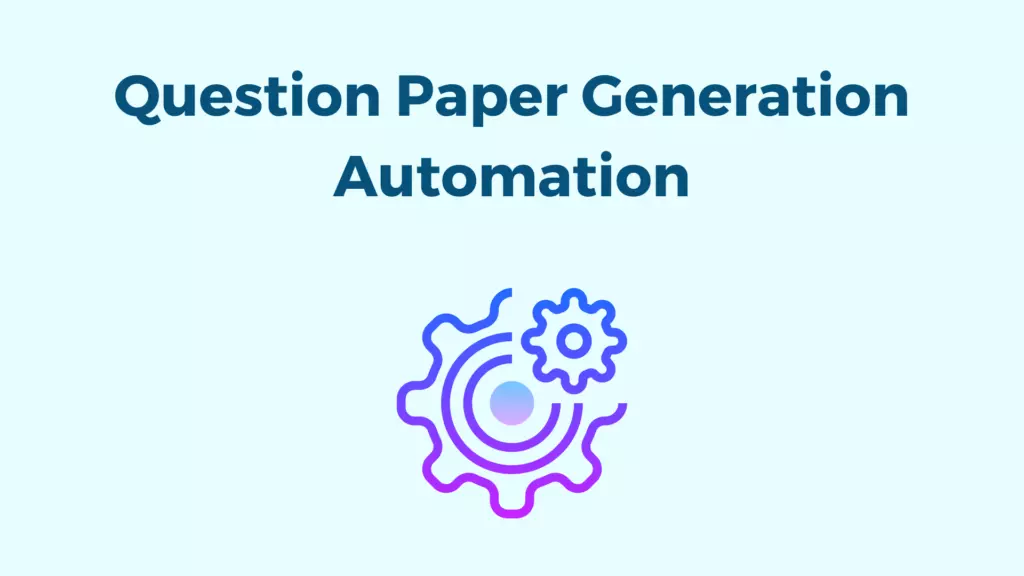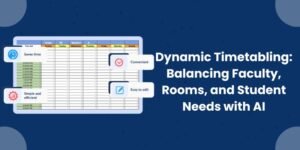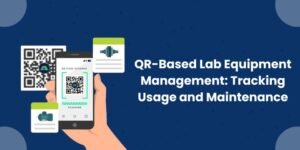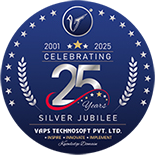Creating question papers has always been a meticulous task for educators. Ensuring that each paper aligns with the syllabus and maintains a balanced difficulty level adds to the complexity. With academic calendars tightening and class sizes growing, educators often find themselves under pressure to prepare quality assessments quickly.
With the advent of technology, automated question paper generation has emerged as a powerful solution. These tools streamline the process, save time, and enhance the quality of assessments by ensuring syllabus alignment and varied difficulty levels. In this blog post, we will explore what automated question paper generation is, why it matters, how it works, and how platforms like VAPS’ i-Vidyalaya can make a real difference.
Why Traditional Paper Setting Falls Short
Manual Effort and Time Consumption

Creating a balanced question paper from scratch is time-consuming. Teachers must gather questions from textbooks, previous exams, and other sources, then ensure they align with the syllabus. Formatting and checking for repetition or overlap is another lengthy task.
Risk of Human Error
Even experienced educators can make mistakes. A question may be accidentally repeated, a topic may be underrepresented, or the difficulty level may be skewed. These errors can lead to unfair assessments and student dissatisfaction.
Inconsistent Standards
When multiple educators create question papers for the same subject or across campuses, inconsistencies can arise. One paper may be too difficult while another is too easy. This leads to disparities in student evaluation.
Security Challenges
In institutions where papers are shared manually via email or printouts, there’s always the risk of leaks or unauthorized access. The integrity of the assessment process is at stake.
What Is Automated Question Paper Generation?
Automated question paper generation is the use of software to create exam papers from a pre-approved question bank. The system allows you to define parameters such as subject, chapter, question type, marks, and difficulty level. Based on this, it compiles a set of questions that meet all the criteria.
Features of a Good Automated Paper Generator
Syllabus Mapping
The system ensures every selected question aligns with the academic syllabus. Each topic and subtopic can be tagged, and the software ensures even distribution across the curriculum.
Difficulty Balancing
Educators can assign difficulty tags to questions—easy, medium, and hard. The software ensures a mix of questions so the paper is neither too easy nor too challenging.
Question Type Variety
Multiple choice questions (MCQs), short answers, long answers, true or false, match the following—automated systems can manage a range of question formats. You can specify how many of each type you want, and the generator will handle it.
Multiple Versions
Need to create different sets of the same exam for multiple batches or to reduce cheating? No problem. The software can randomize questions or change their order to generate multiple versions instantly.
Time-Saving
What used to take hours or even days can now be done in minutes. Teachers can focus on reviewing the generated paper rather than building it from scratch.
Real-Time Updates
If the syllabus changes mid-year or a new chapter is added, it’s easy to update the question bank. You don’t have to start over—just refresh and regenerate.
How the Process Works
Let’s walk through a typical flow:
- Build the Question Bank: Teachers upload questions, tagging each one with metadata such as topic, difficulty, type, and marks.
- Set Exam Parameters: Choose the subject, chapters to include, types of questions, difficulty ratio, and total marks.
- Generate Paper: The system instantly compiles the questions based on your input.
- Review and Edit: Teachers can review the paper, replace questions, or tweak formatting before finalizing.
- Export and Print: The final paper can be downloaded, printed, or shared digitally.
Benefits for Students and Teachers
For Teachers
- Less time spent formatting and selecting questions.
- Reduced stress during exam season.
- More consistency across papers and terms.
- Ability to store and reuse question sets in the future.
For Students
- More balanced assessments.
- Fair evaluation across sections or campuses.
- Exposure to a wider variety of question types.
- Less chance of question paper repetition from previous years.
Use Cases in Large Institutions
Large universities and colleges, especially those with multiple departments and campuses, benefit immensely from automation. Imagine managing exams for thousands of students across various streams. Manual processes are not only slow but also highly error-prone. With an automated system, exam controllers can create department-specific question papers that maintain a consistent standard across the institution.
The Role of AI and Machine Learning
Some advanced systems incorporate AI to analyze patterns from past exams. They can:
- Predict which topics need more coverage based on performance trends.
- Recommend balanced papers based on historical data.
- Avoid question repetition from recent papers.
This predictive capability takes assessment planning to the next level.
Security and Confidentiality
Most modern tools come with built-in encryption and access control. Only authorized users can generate or download question papers. Logs can track who accessed the paper and when, adding an additional layer of accountability.
Integration with ERP Systems
Here’s where platforms like VAPS’ i-Vidyalaya come into the picture. i-Vidyalaya isn’t just an ERP system—it’s a complete academic ecosystem. Its exam module includes automated question paper generation that integrates directly with your academic timetable, subject distribution, and student database.
That means no more juggling multiple tools or manual data entry. Once the exam parameters are set, i-Vidyalaya fetches everything it needs from your existing records. The generated paper can also be mapped to student profiles for recordkeeping, analytics, and performance tracking.
The interface is intuitive, and educators can generate, review, and publish papers without needing technical support. This kind of integration reduces workload and improves transparency across departments.
Real-World Example
Consider a university with five faculties, each running independent examinations every term. Traditionally, each department would assign faculty to manually prepare question papers, which would then undergo multiple review rounds. With an automated system like i-Vidyalaya’s, departments simply upload their question banks once. From there, each exam cycle takes just minutes to manage.
The result? More time for quality assurance, better workload management for staff, and consistent, fair assessments for students.
Future Trends
We’re just scratching the surface. In the near future, expect to see:
- Natural language processing tools that can convert lecture notes into quiz questions.
- AI-curated practice papers tailored to individual student weaknesses.
- Cloud-based collaboration where multiple faculty members contribute to shared question banks in real time.
These innovations will make exam creation even more seamless.
Automated question paper generation is no longer a luxury. It’s a necessity for educational institutions that want to maintain fairness, save time, and deliver better academic experiences.
When combined with a well-integrated ERP like VAPS’ i-Vidyalaya, the process becomes even more efficient and reliable. It’s not just about automation. It’s about empowering educators to focus on what they do best- teaching—while letting technology handle the rest.
If your institution is still relying on spreadsheets and emails to manage exam papers, now is the time to upgrade. Smart, automated tools are the future – and the future is already here.











